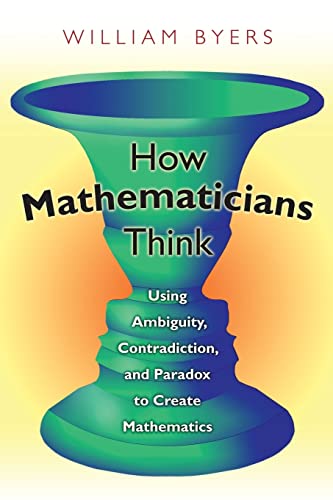How Mathematicians Think: Using Ambiguity, Contradiction, and Paradox to Create Mathematics - Couverture souple

Synopsis
To many outsiders, mathematicians appear to think like computers, grimly grinding away with a strict formal logic and moving methodically--even algorithmically--from one black-and-white deduction to another. Yet mathematicians often describe their most important breakthroughs as creative, intuitive responses to ambiguity, contradiction, and paradox. A unique examination of this less-familiar aspect of mathematics, How Mathematicians Think reveals that mathematics is a profoundly creative activity and not just a body of formalized rules and results.
Nonlogical qualities, William Byers shows, play an essential role in mathematics. Ambiguities, contradictions, and paradoxes can arise when ideas developed in different contexts come into contact. Uncertainties and conflicts do not impede but rather spur the development of mathematics. Creativity often means bringing apparently incompatible perspectives together as complementary aspects of a new, more subtle theory. The secret of mathematics is not to be found only in its logical structure. The creative dimensions of mathematical work have great implications for our notions of mathematical and scientific truth, and How Mathematicians Think provides a novel approach to many fundamental questions. Is mathematics objectively true? Is it discovered or invented? And is there such a thing as a "final" scientific theory? Ultimately, How Mathematicians Think shows that the nature of mathematical thinking can teach us a great deal about the human condition itself.Les informations fournies dans la section « Synopsis » peuvent faire référence à une autre édition de ce titre.
À propos de l?auteur
William Byers is professor of mathematics at Concordia University in Montreal. He has published widely in mathematics journals.
Les informations fournies dans la section « A propos du livre » peuvent faire référence à une autre édition de ce titre.
Autres éditions populaires du même titre
Résultats de recherche pour How Mathematicians Think: Using Ambiguity, Contradiction,...
How Mathematicians Think: Using Ambiguity, Contradiction, and Paradox to Create Mathematics
Vendeur : HPB-Ruby, Dallas, TX, Etats-Unis
paperback. Etat : Very Good. Connecting readers with great books since 1972! Used books may not include companion materials, and may have some shelf wear or limited writing. We ship orders daily and Customer Service is our top priority! N° de réf. du vendeur S_447367123
Acheter D'occasion
Expédition nationale : Etats-Unis
Quantité disponible : 1 disponible(s)
How Mathematicians Think: Using Ambiguity, Contradiction, and Paradox to Create Mathematics
Vendeur : Orion Tech, Kingwood, TX, Etats-Unis
paperback. Etat : Good. N° de réf. du vendeur 0691145997-3-29519731
Acheter D'occasion
Expédition nationale : Etats-Unis
Quantité disponible : 1 disponible(s)
How Mathematicians Think: Using Ambiguity, Contradiction, and Paradox to Create Mathematics
Vendeur : ThriftBooks-Dallas, Dallas, TX, Etats-Unis
Paperback. Etat : Good. No Jacket. Pages can have notes/highlighting. Spine may show signs of wear. ~ ThriftBooks: Read More, Spend Less. N° de réf. du vendeur G0691145997I3N00
Acheter D'occasion
Expédition nationale : Etats-Unis
Quantité disponible : 1 disponible(s)
How Mathematicians Think: Using Ambiguity, Contradiction, and Paradox to Create Mathematics
Vendeur : ThriftBooks-Atlanta, AUSTELL, GA, Etats-Unis
Paperback. Etat : Good. No Jacket. Pages can have notes/highlighting. Spine may show signs of wear. ~ ThriftBooks: Read More, Spend Less. N° de réf. du vendeur G0691145997I3N00
Acheter D'occasion
Expédition nationale : Etats-Unis
Quantité disponible : 1 disponible(s)
How Mathematicians Think: Using Ambiguity, Contradiction, and Paradox to Create Mathematics
Vendeur : One Planet Books, Columbia, MO, Etats-Unis
paperback. Etat : Good. Sixth. Ships in a BOX from Central Missouri! May not include working access code. Will not include dust jacket. Has used sticker(s) and some writing and/or highlighting. UPS shipping for most packages, (Priority Mail for AK/HI/APO/PO Boxes). N° de réf. du vendeur 001015689U
Acheter D'occasion
Expédition nationale : Etats-Unis
Quantité disponible : 1 disponible(s)
How Mathematicians Think: Using Ambiguity, Contradiction, and Paradox to Create Mathematics
Vendeur : Heartwood Books, A.B.A.A., Charlottesville, VA, Etats-Unis
Trade Paperback. Etat : Good Plus. Good Plus, internally clean, solid paperback with minor corner bumping. #. N° de réf. du vendeur 19916
Acheter D'occasion
Expédition nationale : Etats-Unis
Quantité disponible : 1 disponible(s)
How Mathematicians Think : Using Ambiguity, Contradiction, and Paradox to Create Mathematics
Vendeur : GreatBookPrices, Columbia, MD, Etats-Unis
Etat : good. May show signs of wear, highlighting, writing, and previous use. This item may be a former library book with typical markings. No guarantee on products that contain supplements Your satisfaction is 100% guaranteed. Twenty-five year bookseller with shipments to over fifty million happy customers. N° de réf. du vendeur 7594744-5
Acheter D'occasion
Expédition nationale : Etats-Unis
Quantité disponible : 1 disponible(s)
How Mathematicians Think: Using Ambiguity, Contradiction, and Paradox to Create Mathematics
Vendeur : Textbooks_Source, Columbia, MO, Etats-Unis
Paperback. Etat : Good. Sixth. Ships in a BOX from Central Missouri! May not include working access code. Will not include dust jacket. Has used sticker(s) and some writing or highlighting. UPS shipping for most packages, (Priority Mail for AK/HI/APO/PO Boxes). N° de réf. du vendeur 001015689U
Acheter D'occasion
Expédition nationale : Etats-Unis
Quantité disponible : 1 disponible(s)
How Mathematicians Think: Using Ambiguity, Contradiction, and Paradox to Create Mathematics
Vendeur : Olimpianbooks, Avon Lake, OH, Etats-Unis
Soft cover. Etat : New. 5th or later Edition. N° de réf. du vendeur A9 abe mid
Acheter neuf
Expédition nationale : Etats-Unis
Quantité disponible : 1 disponible(s)
How Mathematicians Think: Using Ambiguity, Contradiction, and Paradox to Create Mathematics
Vendeur : WeBuyBooks, Rossendale, LANCS, Royaume-Uni
Etat : Like New. Most items will be dispatched the same or the next working day. An apparently unread copy in perfect condition. Dust cover is intact with no nicks or tears. Spine has no signs of creasing. Pages are clean and not marred by notes or folds of any kind. N° de réf. du vendeur wbs4140044676
Acheter D'occasion
Expédition depuis Royaume-Uni vers Etats-Unis
Quantité disponible : 1 disponible(s)

